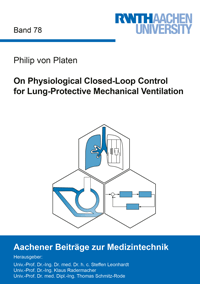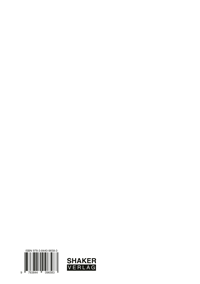
Shop : Details
Shop
Details
59,80 €ISBN 978-3-8440-9658-3Softcover226 pages112 figures294 g21 x 14,8 cmEnglishThesis
October 2024
Philip von Platen
On Physiological Closed-Loop Control for Lung-Protective Mechanical Ventilation
Mechanical ventilation remains the cornerstone of respiratory support and treatment for patients with acute respiratory failure. However, it is a double-edged sword as it can further damage the injured lung. Therefore, its use requires constant and careful adjustment of ventilator parameters, making it workforce-intensive and costly. Physiological closed-loop control of mechanical ventilation presents an opportunity to address some of these challenges.
The respiratory system is the gateway for ventilation and gas exchange, and the small signal behaviour under tidal mechanical ventilation is well-studied. This work dedicates extensive study to the large signal behaviour, which includes the non-linear hysteretic phenomenon that significantly affects the operating points of tidal ventilation. A mathematical Preisach hysteresis model of the respiratory system was developed. Once parameterised, this model could replicate clinically measured pressure-volume curves accurately. Moreover, this model allowed for the simulation of clinical manoeuvres, such as a disconnection from the mechanical ventilator and positive end-expiratory pressure titrations, and lays the foundation for further automation of clinical manoeuvres.
Tight control of the systemic oxygenation is a core requirement for any closed-loop system for mechanical ventilation. Physiological modelling of the disturbed gas exchange was performed to highlight the non-linear, uncertain, and time-varying relationship between the inspired oxygen and the resulting subject’s oxygen saturation, especially in cases of acute lung injury. Closed-loop controllers were designed to focus on reliability, robustness and transparency, and both a rule-based and a robust proportional-integral controller were synthesised. Results from extensive simulations and animal experiments show the controllers to be accurate, reliable and safe despite the significant uncertainties in the process.
A complete physiological closed-loop control system, called SOLVe, is also introduced. It addresses the two main targets of mechanical ventilation strategies, namely gas exchange and lung-protective ventilation, and could adjust all ventilator variables automatically. The system includes four controllers, various continuous physiological measurements and an online estimation of the respiratory mechanics. A heuristic rule-based hierarchy resolves conflicting targets and actions between controllers. Results from two animal trials with pigs demonstrate that the SOLVe system could keep subjects within defined targets while adhering to lung-protective guidelines. At the same time, limited clinical interactions were required during the experiments, suggesting the potential of such a system to reduce clinician workload.
The respiratory system is the gateway for ventilation and gas exchange, and the small signal behaviour under tidal mechanical ventilation is well-studied. This work dedicates extensive study to the large signal behaviour, which includes the non-linear hysteretic phenomenon that significantly affects the operating points of tidal ventilation. A mathematical Preisach hysteresis model of the respiratory system was developed. Once parameterised, this model could replicate clinically measured pressure-volume curves accurately. Moreover, this model allowed for the simulation of clinical manoeuvres, such as a disconnection from the mechanical ventilator and positive end-expiratory pressure titrations, and lays the foundation for further automation of clinical manoeuvres.
Tight control of the systemic oxygenation is a core requirement for any closed-loop system for mechanical ventilation. Physiological modelling of the disturbed gas exchange was performed to highlight the non-linear, uncertain, and time-varying relationship between the inspired oxygen and the resulting subject’s oxygen saturation, especially in cases of acute lung injury. Closed-loop controllers were designed to focus on reliability, robustness and transparency, and both a rule-based and a robust proportional-integral controller were synthesised. Results from extensive simulations and animal experiments show the controllers to be accurate, reliable and safe despite the significant uncertainties in the process.
A complete physiological closed-loop control system, called SOLVe, is also introduced. It addresses the two main targets of mechanical ventilation strategies, namely gas exchange and lung-protective ventilation, and could adjust all ventilator variables automatically. The system includes four controllers, various continuous physiological measurements and an online estimation of the respiratory mechanics. A heuristic rule-based hierarchy resolves conflicting targets and actions between controllers. Results from two animal trials with pigs demonstrate that the SOLVe system could keep subjects within defined targets while adhering to lung-protective guidelines. At the same time, limited clinical interactions were required during the experiments, suggesting the potential of such a system to reduce clinician workload.
Keywords: Mechanical Ventilation; Closed-Loop Control; Robust Control; Physiological Modelling; Hysteresis Modelling
Aachener Beiträge zur Medizintechnik
Edited by Univ.-Prof. Dr.-Ing. Dr. med. Steffen Leonhardt, Univ.-Prof. Dr.-Ing. Klaus Radermacher and Univ.-Prof. Dr. med. Dipl.-Ing. Thomas Schmitz-Rode, Aachen
Volume 78
Available online documents for this title
DOI 10.2370/9783844096583
You need Adobe Reader, to view these files. Here you will find a little help and information for downloading the PDF files.
Please note that the online documents cannot be printed or edited.
Please also see further information at: Help and Information.
Please also see further information at: Help and Information.
| Document |  | Document | ||
| Type |  | |||
| Costs |  | 44,85 € | ||
| Action |  | Purchase in obligation and download the file | ||
| Document |  | Table of contents | ||
| Type |  | |||
| Costs |  | free | ||
| Action |  | Download the file | ||
User settings for registered online customers (online documents)
You can change your address details here and access documents you have already ordered.
User
Not logged in
Export of bibliographic data
Shaker Verlag GmbH
Am Langen Graben 15a
52353 Düren
Germany
Am Langen Graben 15a
52353 Düren
Germany
Mon. - Thurs. 8:00 a.m. to 4:00 p.m.
Fri. 8:00 a.m. to 3:00 p.m.
Fri. 8:00 a.m. to 3:00 p.m.
Contact us. We will be happy to help you.



